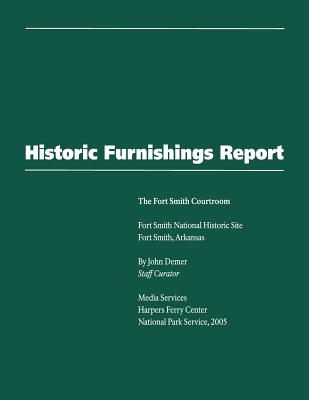
Historic Furnishings Report - The Fort Smith Courtroom
Description
On September 13, 1961, Congress authorized Fort Smith National Historic Site by Public Law 87-215. According to its 1994 statement of park significance, Fort Smith National Historic Site "preserves the site of two frontier forts and the site of the Federal Court for the Western District of Arkansas, including the Indian Territory." To fulfill its obligation to Fort Smith's enabling legislation, National Park Service interpretation can be grouped into the following three periods: First Fort: continuous military occupation from 1817 to 1824, then intermittent military occupation from 1824 to 1834; Second Fort: intermittent military occupation from 1838 to 1851; continuous military occupation from 1851 to 1871 (including occupation by the Confederacy during the Civil War);Federal Court: judicial era from 1872 to 1896 In brief: the term "First Fort" refers to a fort the Army built on a bluff at the confluence of the Arkansas and Poteau Rivers. The Army occupied the first Fort Smith continuously from 1817 to 1824, then intermittently to 1834. During this 17-year period, the Army helped maintain order between two principal Indian nations, the Cherokee and the Osage. "The intermittent use of the fort from 1824 to 1838 was tied to the forced removal of the Five Tribes-Cherokee, Chickasaw, Choctaw, Creek, and Seminole-beginning in 1830."These nations were moved to lands historically occupied by the Osage. The removal of these nations provided the need to authorize a second fort. The term "Second Fort" refers to remains of a second fort slightly to the northeast of the present courtroom and jail. This second fort served primarily as a supply depot. From 1838 to 1851, the Army occupied this second Fort Smith site intermittently, and from 1851 to 1871 an army occupied the second fort continuously. The term "an army" is appropriate because during the Civil War federal and confederate armies occupied the second fort. The term "federal court" refers to the use of Army buildings as a federal court. In 1872, the year after the Army vacated Fort Smith, the U.S. Court for the Western District of Arkansas moved into the Army's former barracks building. The federal court modified the barracks into a courthouse and added a wing for a jail in 1887. The court used this federal jail until 1917. The federal government maintained control of the building until 1920. The principal figure of federal occupancy from 1875 to 1889 was Judge Isaac Charles Parker (1838-96). Judge Parker served at Fort Smith from 1875 to 1896. In 21 years on the bench, he heard more than 12,000 cases. Fort Smith NHS represents the site of the Federal Court for the Western District of Arkansas by preserving the courtroom to its appearance in 1883. In one part of this historic building (completed as a military barrack in 1851 and converted to a courtroom in 1872), visitors will view furnishings representing the building's use as a courtroom. This historic furnishings report summarizes primary evidence of objects in the courtroom for the years 1872 to 1883; it then recommends objects appropriate for a historic furnishing of the courtroom to the appearance of the room in 1883. The principal reason the report recommends 1883 as the date of interpretation is that a description of the contemporary appearance of the courtroom appears in a secondary account of a trial occurring in that year. The trial was that of Mat Music, an accused man who tried to escape during his trial by diving through a doorway to the right of Judge Parker. More detail about that trial and the newspaper description come later in this report.

